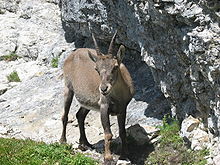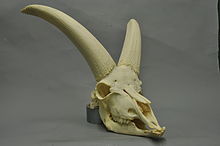Alpine Ibex
| Alpine Ibex | ||||||||||||
|---|---|---|---|---|---|---|---|---|---|---|---|---|

Alpine ibex ( Capra ibex ), male animal |
||||||||||||
| Systematics | ||||||||||||
|
||||||||||||
| Scientific name | ||||||||||||
| Capra ibex | ||||||||||||
| Linnaeus , 1758 |
The alpine ibex ( Capra ibex ) or common ibex - to distinguish it from other ibex - is a goat species that is widespread in the Alps . A female ibex is called a stone goat .
features
An Alpine ibex has an average head length of 150 cm and a shoulder height of 90 cm. Goats weigh around 40 kg, whereas goats can weigh over 100 kg. The buck has imposing, curved horns (up to 1 m in length), while the goat has only short, barely curved horns. The goats have a goatee. In summer, bucks have a dark brown fur; the fur of the females is more reddish or golden brown. In winter, the fur of both sexes turns gray.
In 2012, the remains of an Alpine ibex were excavated and examined on the Rotmoosferner in the rear Ötztal , Austria . They were determined to be at least 3,300 years old and prove that the specimens were somewhat larger at the time. The 40 cm long part of a horn was first exhibited in 2014 in the Bolzano Archaeological Museum.
habitat
In the Alps, the ibex lives at the height between the forest and ice line . It rises to heights of 3500 m. In winter, however, it stays at lower altitudes than in summer, and in summer too it often descends on alpine meadows to eat while it goes to the great heights to spend the night.
Way of life
A herd of ibex is made up of ten to twenty females and young animals. In addition, there are the less stable herds of bachelors who are not yet fully grown and old bucks living individually. During the breeding season in the Alps in December / January, the bucks seek out the females and try to gain control of the herd. Fighting occurs between competing goats. A buck must be at least six years old to have a chance of surviving these fights and winning a harem. The buck stays with the herd over winter and leaves it in spring.
After a gestation period of five to six months, a young animal (fawn), rarely two, is born between May and the end of June. The young can walk from day one and is suckled by the mother for a year. The lifespan of an ibex can be over twenty years.
The reintroduction of ibex in the Alps has shown in some regions that ibex has a major impact on the landscape around them. Due to the reintroduction of the ibex in the 1920s, slope erosion increased in the area of the Schafberg and Piz Albris near Pontresina in the Upper Engadine . Responsible for this were represented damage to the ibex.
Capricorn and human

In the Paleolithic and up to the Neolithic Age , ibex were the main game for humans in some mountainous regions for millennia .
The Capricorn was heavily mystified in earlier times, which meant that almost everything that could be used in Capricorn, from blood to hair to excrement , was used as medicine against various diseases. This almost led to the species becoming extinct in Europe. In the middle of the 17th century the alpine ibex was exterminated on the territory of the house of worship , of which it was heraldic animal, and by the beginning of the 19th century the ibex was wiped out in the entire Alpine region with the exception of about 100 animals in Gran Paradiso, Italy . The Gressoney forester Josef Zumstein and the naturalist Albert Girtanner were able to persuade the authorities in 1820 to protect the last ibex in Gran Paradiso. From 1821 ibexes were placed under protection in the entire area of the House of Savoy . In 1856 King Victor Emmanuel II of Sardinia-Piedmont made the region one of his hunting grounds and employed a large number of game rangers. The population grew to 3000 animals by the end of the 19th century. Thanks to successful reintroduction programs, the ibex from the former stock of less than 100 animals is now spread again in large parts of its original habitat . All ibex living in the Alps today are descended from these 100 animals.
Although Switzerland (whose canton Graubünden at least bears the animal in its coat of arms) repeatedly made requests for ibex, Victor Emanuel III allowed . the export of ibex does not. In 1906 the first animals were smuggled into Switzerland and brought to the Peter and Paul Wildlife Park near St. Gallen , where they were bred. In 1911 the first unsuccessful release campaign took place with these animals. From 1915 ibexes were also brought to the Harder Alpine Game Park near Interlaken for breeding, first a breeding pair from the Peter and Paul Game Park, then directly from the Gran Paradiso. The successful settlement in the Graubünden mountains began in 1920. All the ibex living in Switzerland today are descended from animals from the two zoos mentioned above.
Stocks
The Alpine Ibex is not endangered ( IUCN Least Concern ). In Switzerland 17 147 animals live (as of 2011) and in Italy 13,500 ibex, corresponding together two thirds of the total population in the Alps, which comprises about 45,000 animals. In Switzerland, where the successful resettlement began in 1920, the population has been regulated by hunting since 1977.
The population in Austria , where the first animals were successfully resettled in 1924, amounts to 4500 animals. The resettlement of alpine ibex usually finds broad support from the population and the municipalities , since a population of ibex is often used in the tourist marketing of alpine holiday resorts.
Around 10,000 ibex live in the French Alps (as of 2014), mainly in the Mercantour National Park , on whose territory in the Maritime Alps , which belonged to Italy until 1947, resettlement began as early as 1921, and in the Vanoise National Park , the largest with around 2500 animals French ibex population.
There are five populations in Germany: two smaller ones near the Graswangtal / Ammerwald and near Bayrischzell and three larger ones in the Allgäu Alps , on the Benediktenwand and in the Hagengebirge . The repopulation in the German Alps began in 1936 near Berchtesgaden . In an official census in 2010, foresters and hunters identified 450 Alpine ibex in Bavaria's mountains; in the summer of 2016 there were already 730. In Slovenia there are 400 individuals of wild Alpine ibex. In 1971 the first specimens also appeared on the Falknis in Liechtenstein .
Systematics
The alpine ibex is one of several species of the goat genus ( Capra ) known as ibex . In the past, due to its external characteristics, it was combined into one species with the Siberian ibex ( C. sibirica ) and the Nubian ibex ( C. nubiana ).
Genetic studies, however, strongly suggest that the Alpine ibex, Siberian ibex and Nubian ibex each represent their own species, with the Siberian ibex at the base of the wild goat species . The external similarities to the Alpine ibex and the Nubian ibex would therefore not be a sign of close relationship, but rather plesiomorphies . The Alpine Ibex, on the other hand, is genetically similar to the Iberian Ibex , which is very different from the outside and is geographically closest to it.
literature
- Robert Hofrichter: The return of the wild animals. Wolf, Geier, Elch & Co. Stocker, Graz, 2005, ISBN 3-7020-1059-9 .
- Marco Giacometti (ed.): From kings and poachers. The rescue and resettlement of the Alpine Ibex. Salm, Bern 2006, ISBN 3-7262-1415-1 .
- Peter Meile, Peider Ratti, Marco Giacometti: The Capricorn. Biology and hunting. Salm, Bern 2003, ISBN 3-7262-1412-7 .
- DE Wilson, DM Reeder: Mammal Species of the World. Johns Hopkins University Press, Baltimore 2005, ISBN 0-8018-8221-4 .
- Eugenio Dupré, Luca Pedrotti, Serena Arduino: Alpine Ibex Conservation Strategy. Varese 2001 (study on the distribution of the ibex in the Italian Alps, English).
- Parc National de la Vanoise (Ed.): Le Guide du Parc National de la Vanoise. Glénat, Grenoble 2003, ISBN 2-7234-4304-3 .
- Rudolf Käch: Ibex - King of the Alps. Verlag von Ah Druck, Sarnen 2013, ISBN 978-3-9524104-0-0 .
- Wolfgang Schröder, Photos: Pete Dine: Ibexes: They got away again .... In: Geo-Magazin. Hamburg 1979.3, pp. 96-112. Informative experience report: "As a> jumping pharmacy <and hunting trophy in equal measure, they were almost wiped out 125 years ago. It is thanks to an Italian king that the last 50 were saved. Today 14,000 ibex are climbing again in the Alps." ISSN 0342-8311
Web links
- Capra ibex in the Red List of Threatened Species of the IUCN 2008. Posted by: S. Aulagnier u. a., 2008. Retrieved December 31, 2008.
- South Tyrolean hunting portal: comprehensive description - u. a. with explanations and sketches about the antlers
- Alpine Ibex at zoodirektoren.de - u. a. with data on reintroduction, population numbers and species protection projects , accessed on October 12, 2011
Individual evidence
- ↑ Glacier find : Ibex remains from the Bronze Age. ORF.at from February 25, 2014
- ↑ Ivana Fiore, Antonio Tagliacozzo, Pier Francesco Cassoli: Ibex exploitation at Dalmeri rockshelter (TN) and "specialized hunting" in the sites of the Eastern Alps during the Tardiglacial and the early Holocene. ( Memento of July 8, 2014 in the Internet Archive ) In: Preistoria Alpina 1998, Volume 34, pp. 173-183.
- ^ Joseph Edward Beaver: Paleolithic Ungulate hunting: simulation and mathematical modeling for archaeological interference and explanation. Dissertation, University of Arizona, 2007.
- ^ Jon Mathieu (1987), Farmers and Bears . Octopus, Chur.
- ^ History. In: Parco Nazionale Gran Paradiso. Archived from the original on December 24, 2018 ; accessed on December 24, 2018 .
- ↑ Laura Riley, William Riley: Nature's Strongholds: The World's Great Wildlife Reserves . Princeton University Press, 2005, ISBN 0-691-12219-9 , pp. 390-392 .
- ↑ Stüwe, M., Nievergelt, B .: Recovery of Alpine ibex from near extinction: the result of effective protection, captive breeding, and reintroductions . In: Applied Animal Behavior Science . tape 29 , no. 1-4 , 1991, pp. 379-387 , doi : 10.1016 / 0168-1591 (91) 90262-V .
- ↑ a b Canton of Graubünden: 100 years of ibex in Switzerland: Canton of Graubünden is celebrating resettlement
- ^ S. Aulagnier et al .: Capra ibex on the IUCN website, accessed February 14, 2019
- ^ Federal hunting statistics of the Federal Office for the Environment FOEN , selection: protected mammals, ibex, all of Switzerland, population, figures; Retrieved September 12, 2012
- ↑ Les bouquetins en France ( Memento of January 22, 2015 in the Internet Archive )
- ↑ Süddeutsche Zeitung : The ibex is on the advance in Bavaria , December 5, 2016
- Jump up ↑ EY Kazanskayal, MV Kuznetsoval, AA Danilkin: Phylogenetic Reconstructions in the Genus Capra (Bovidae, Artiodactyla) Based on the Mitochondrial DNA Analysis. In: Russian Journal of Genetics. Vol. 43, No. 2, 2007, pp. 181-189 ( doi: 10.1134 / S1022795407020135 )





